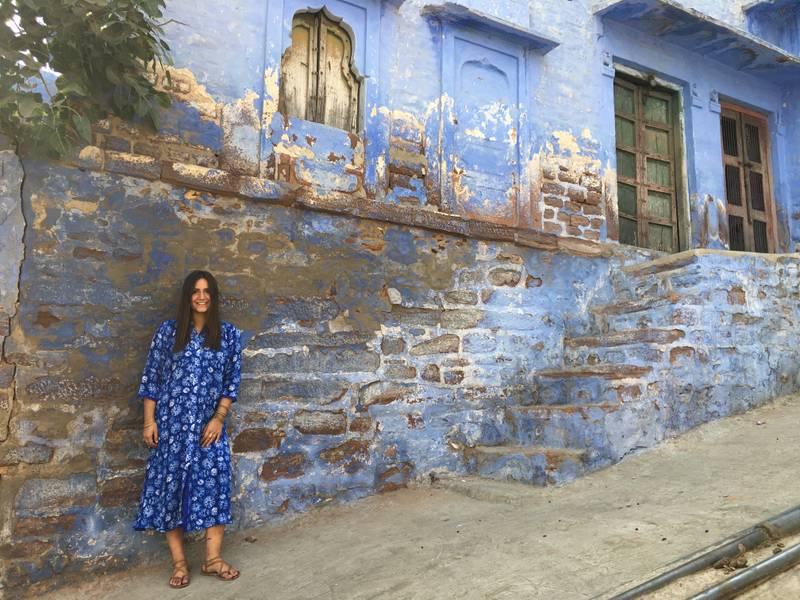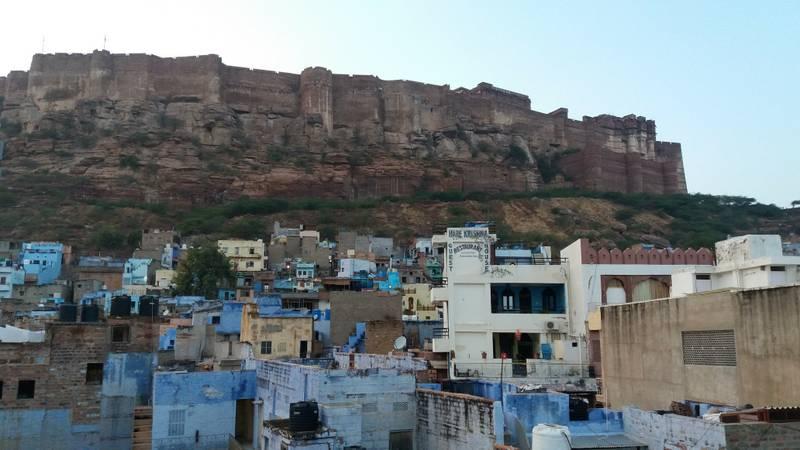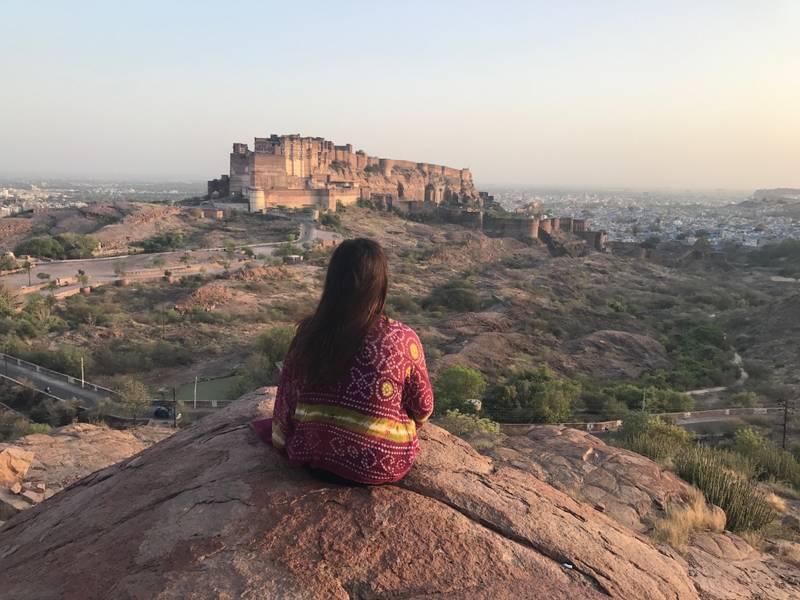The ‘life as a nomad’ series returns! ‘Life as a Nomad‘ is an occasional series that focuses on the nomadic life and where nomads have lived it. Read the whole ‘Life as a Nomad’ series, including guest posts from fellow nomads.
So, tell me about Jodhpur, India?
Jodhpur is an old-fashioned Indian town tucked away in the Thar desert in India’s Rajasthan state. It’s home to one of the most regal structures in the nation, the Mehrangarh Fort, which you may recognize from Dark Knight Rises. Previously, I partook in the One Weird Globe article about Where Digital Nomads are Heading in 2017 where I detailed the serious affordability of Digital Nomad life in Jodhpur. For instance, for room and board I paid about $215 and 3GB of monthly data through Vodafone is $15.
When did you live there?
I was living in India for six months of 2017 and spent almost three months in the blue city of Rajasthan.
But why Jodhpur?
For a year I’d been planning to go work pro-bono with an NGO in India. I vetted hundreds of organizations from around the country that focused on projects to aid and enhance the lives of vulnerable women and children in their communities. I accepted a role as a communications officer with Sambhali Trust which has been helping at-risk women in Rajasthan for over a decade with developmental programs for vocational training, basic English, and math, as well as an S.O.S. helpline. I wasn’t too concerned about where the NGO was placed as long as it was highly credible and had clear a and sustainable path to eradicate the issue they’re fighting against. Sambhali Trust has seen over 10,000 beneficiaries and with my background in fashion, I knew working with a charity that focused on teaching sewing, embroidery and other textile skills was the right fit.
Why Jodhpur as opposed to Delhi or Mumbai?
I had initially had some very inspiring meetings with wonderful nonprofits and grassroots organizations in both major cities. New Delhi would have been impossible for me with its high smog levels as I have asthma. Mumbai was very tempting as it appears to have everything I loved, great cafes, seaside escapes, art galleries, and phenomenal history. After visiting I do love Mumbai and can certainly imagine myself living there. Delhi however is not a special place for me.
Jodhpur was an excellent choice for me. It turned out to be very authentic with minimal modern influence. Camels, elephants, and cows battle rickshaws for space on narrow roads. There wasn’t a single western business in town, not even a Starbucks. I was challenged in new ways to adapt to a lifestyle that didn’t offer easy access to the modern amenities I was accustomed too. I got used to daily trips to the local farmer’s market for produce, learned how to haggle, wore traditional clothing, and even did the occasional Bollywood jive. I don’t know if I would have had the same genuine experience had I been in a larger city.
How do you get there?
I traveled around India for about two weeks before settling into life in Jodhpur. I flew to Delhi from Paris, France and then took a train to Jaipur (which I missed due to traffic), another train to Udaipur (my all-time favorite place in India), and then a local bus to Jodhpur which was a harrowing experience. The AC was on full blast and so was the music with the latest Bollywood tunes as locals hopped on and off at random spots on the road with livestock and other odd knick-knacks in hand. I had no idea how foreshadowing that journey would be for the next few months in Jodhpur! If you’re keen to explore more of India, check out this one week itinerary for Rajasthan
Are there many foreigners around?
In the city center near the famous clock-tower, I saw the occasional tourist or two from time to time, never more than 10 or so on one outing. There were many young Europeans who were volunteering with the charity teaching English. Which isn’t something I strongly advocate for, I think only qualified teachers should teach, especially to underserved communities. I speak from a failed experience as a language and cultural ambassador in Spain– a gig I should have never accepted.
Are there many foreign products or services around?
No, but once you adjust you can find everything you need and get into the flow of the local way of life.
What about the language barrier?
Many Indian people speak English, but mostly those who can afford or have been fortunate enough to attend some sort of educational institution at some point in their lives. In Jodhpur, most of the workers at shops, cafes, and tourism entities speak English. However, in the outskirts of the city where I was living English is not locally spoken. Hindi is spoken in various dialects around Jodhpur. Locals in other regions of India speak completely different languages such as Malayalam, the dialect in the Kerala state. It is always wise to learn as many phrases as you can in the local language, especially when visiting suburban or rural places. Even if the person you are speaking to knows some English they will be very grateful that you’ve tried to speak some words in their language and will feel more at ease practicing their English with you. After all, they probably speak much better English than you do their language.
What’s there to see around town? Is it worth coming to Jodhpur as a tourist?
Just like most large towns in Rajasthan Jodhpur has a treasure cove of beauty to be discovered. You can stroll through the daily produce market, get a custom-made sari, enjoy piping hot masala chai tea, and learn how to draw miniatures, all within a minute walk from each other around the central clock tower. The most popular sites to see are the Mehrangarh Fort and the old city, which is the part of the town painted blue. There is so much more to see but sadly most tourist only spend a day here and miss out on many unique experiences such as viewing an ancient stairwell, learning about traditional mehndi design, and visiting the stunning Mandore Gardens. I detail all of these in more in the Jodhpur travel guide on my responsible travel blog, Miss Filatelista.
What’s the best way to get started as a nomad there? Are there many jobs available for nomads like yourself, or is it easy to find clients in the neighborhood?
There is not a large demand for foreign workers in Jodhpur, beyond volunteering with NGOs, work exchanges with hostels, or perhaps a few projects with luxury hospitality groups. It is a better hub for those who work remotely online. Digital nomads will be pleasantly surprised to find strong WiFi at many cozy cafes that allow laptop workers to use the space, as long as they have a meal, of course. See which are the six best cafes to work from in Jodhpur on Miss Filatelista.
Do check the visa regulations before accepting a job in Jodhpur and be sure to read the fine print of what you are and are not allowed to do when traveling in India on a volunteer or work visa. Most nationalities can get a 180-day tourist visa, but you must apply in advance. Americans can get a 10-year tourist visa if they apply in America.
What’s your favorite spot to get local cuisine – a place not frequented by tourists? What about a taste of home or the Western world?
Local food in Jodhpur is worth traveling around the world for! Locals flock to two restaurants that are actually across the street from each other and within walking distance of the city center for Rajasthani dishes at very reasonable prices. Hotel Priya restaurant has a delicious thali and I love the masala dosa from Janta Sweet Home. There aren’t many international restaurants in Jodhpur and the few pizza’s or pasta dishes I had were pretty terrible, but I did live in Florence, Italy before so perhaps I am a harsh critic. My favorite cafe, which is also a great place to work from, is Namaste Caffe and they have some non-Indian dishes on the menu such as falafel, salads, and some pasta.
How did you find a place to live (e.g. where did you look)? What will you do differently the next time out?
I stayed at the guesthouse which is run by the founder of Sambhali Trust and is an extension of his family home. The guesthouse was incredibly charming and it was convenient to be working in the same building. But the profits of the hotel don’t benefit the charity and I realized after I arrived that there were more modern and less expensive options available. I came back to visit Jodhpur before leaving in India and stayed in a few hostels and wish I had been staying there throughout–they had excellent WiFi, beautiful decor, and social environments. My favorite was STOPS Hostel although it is a bit far from the city center. They have a lot of open coworking-type spaces so it would be a fantastic place to be based as a digital nomad in Jodhpur.
Which specific websites, forums, or Facebook groups are worth joining? Which ones aren’t?
Unfortunately, I don’t have any great suggestions here. The organization I worked with didn’t have a guide to resources in Jodhpur and I basically had to figure everything out for myself, but I prefer it that way. I found the Facebook backpacker groups to be resourceful if I needed generic advice. However, whenever I post in these groups I always have 5-10 Indian men messaging me on Facebook after. Likewise, when posting pictures on Instagram, I always get many messages from men asking me where I am and if I want to meet. So, ladies, I suggest you back post when you’re traveling in India, meaning don’t post your location by geotagging an Instagram story or post in real time, wait until you’ve left. The messages will keep coming no matter what you do. Ignore them and report them as spam.
What’s the vibe you get around locals? Do they see you as a potential partner or a threat?
There is no easy answer to this question. We were told we were not allowed to have local friends at the charity where I was working. I’m in my late twenties and well traveled so ignored this sound advice and chatted with whoever I felt like chatting with. Most young Indians loved to simply get to know where you’re from and what you think about their country. They just want to make friendly small talk. People are very willing to help you if they can and want to make sure you’re enjoying your time.
I am not so friendly when I am in a situation where there are only men around. I usually get myself out of there as quickly as possible. I’d rather be safe than sorry and on multiple occasions, I was made to feel like an object by the way men treated me.
It gets more complicated when you’re interacting with people who do not understand you because of a language barrier. For instance, it can be mind boggling to communicate with a rickshaw driver who can’t read a map and will just drop you off wherever he pleases. Make sure you get a local sim card so you can always get yourself out of a sticky bind by using Google maps for directions or calling someone for assistance. Local friends will always be there to help you and people are very genuine.
Vendors will also hassle you and see you as a bag of money, even if you aren’t trying to buy anything in their store. Just ignore it. They are just trying to support their family. If you do buy something local know that yes, you’re probably being charged a tourist price. The real price is probably a third of the initial offer. Decide in your head what you’re willing to pay for an item. If you can’t reach an agreement in a pleasant manner simply leave the shop, you can probably find something similar elsewhere. Don’t be a jerk and haggle over what is the equivalent of a dollar. Once you’re living in India long enough you’ll start to know what the average prices are for things-a rickshaw anywhere in Jodhpur is usually less than US$1, local clothing is usually US$2-3, and street food is usually less than US$0.50. If someone quotes you something astronomical just don’t even bother, just walk away. You will start to form relationships with vendors who will treat you like family and give you fair prices.
What’s been the most difficult thing to get used to as a nomad in Jodhpur?
Cows! I’ve been nudged and pushed by more than one cow while walking around in Jodhpur. It’s always shocking, and kind of terrifying. They’re huge beasts and could seriously injure you, or you know, poop on you. The latter would be considered seriously lucky, so cross your fingers for that experience! Cows are sacred in India and roam freely. But they can get aggravated so to be safe to cross the street or stray behind one that seems a bit wonky.
On a more serious note, it is very difficult to get used to seeing children begging on the street in India. It is even harder to say no when they ask you for money. I always offer to buy them food instead. I worked with several NGOs for a Matador Network article that details other strategies that can be more beneficial for the children.
Last, but most important question: where’s the best place to get a beer?
I actually went sober while in India so never kept track of where did or did not sell beers. There are several liquor stores around the outskirts of town and you can definitely get an overpriced beer or cocktail at the upscale Stepwell Cafe, which has one of the most beautiful views in town.
You’ve been reading…
Lola Méndez is a full-time traveler sharing her adventures on Miss Filatelista as she adds to her collection of passport stamps. She travels to develop her own worldview and has explored 53 countries. Passionate about sustainable travel she seeks out ethical experiences that benefit local communities. You can follow her on Instagram, Facebook, Twitter, Pinterest, and LinkedIn.
Want to tell your ‘Life as a Nomad‘ story? Head to this page for more information.
Like this post? Like the Facebook page!




